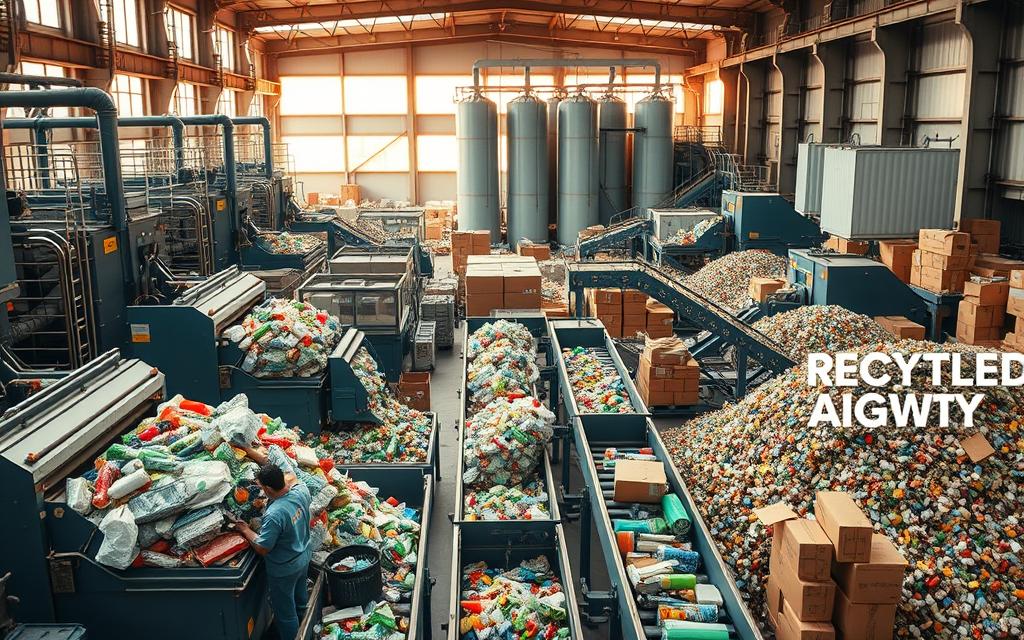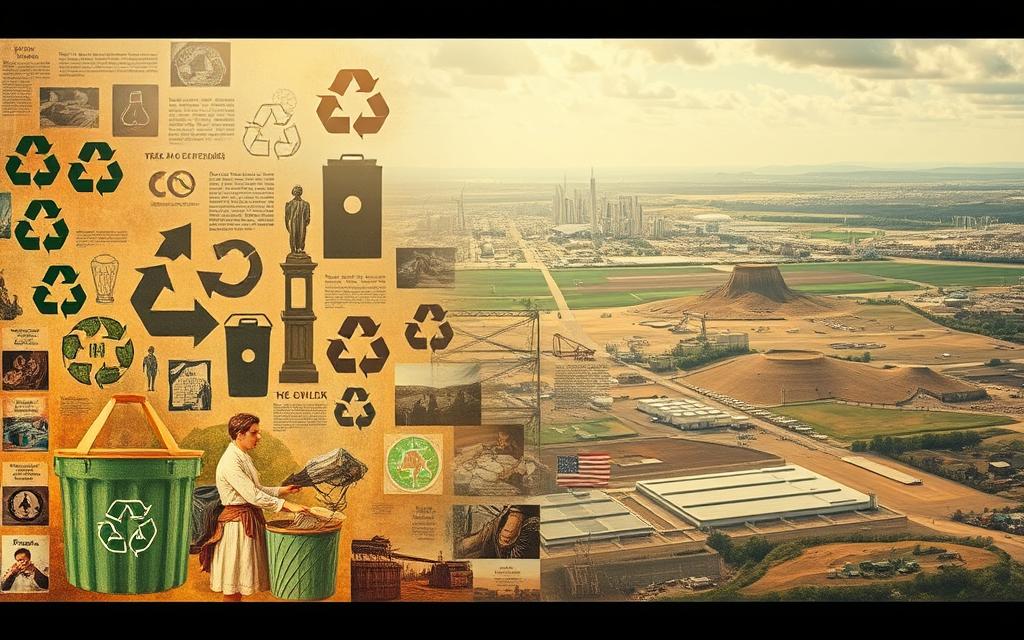Recycling is often seen as a modern idea, but its roots stretch back thousands of years. Early civilizations across the world practiced reusing materials out of necessity. From ancient Rome to Asia Minor, people found ways to repurpose items to conserve resources.
During times of scarcity, such as wars or famines, recycling became essential. For example, metals were melted down and reused, while glass was reshaped into new items. These practices laid the foundation for today’s recycling systems.
Modern recycling practices are deeply connected to these ancient traditions. To learn more about how recycling evolved, check out this detailed history. This article will explore key moments in the history of recycling and how it shaped the world we live in today.
Introduction to Recycling
Long before modern systems, societies found innovative ways to repurpose valuable resources. Recycling began as a survival tactic, driven by the need to conserve materials during times of scarcity. Today, it has evolved into a global movement focused on reducing waste and preserving the environment.
In ancient times, people reused items out of necessity. Metals were melted down, glass was reshaped, and textiles were repaired. This practical approach stood in stark contrast to today’s disposable culture, where convenience often overshadows sustainability.
The industrial revolutions of the 18th and 19th centuries transformed the way we produce and consume goods. Mass production led to increased waste, but it also sparked new ideas about resource management. The concept of a circular economy, where materials are continuously reused, has roots in these early practices.
“The circular economy isn’t a new idea—it’s a return to the sustainable practices of our ancestors.”
This section sets the stage for exploring specific historical case studies. From ancient glass recycling to modern systems, the journey of reusing materials reveals the enduring value of this practice.
When Did Recycling Start?
The practice of reusing materials is far older than most people realize. Evidence of recycling dates back to 400 B.C., with Byzantine glass reuse being one of the earliest examples. This challenges the modern assumption that recycling is a recent development.
Pinpointing the exact origins of recycling is difficult. Early societies reused materials organically, without formal systems. Archaeological findings reveal patterns of glass, metal, and textile reuse across ancient civilizations.

These discoveries highlight the enduring history of recycling. From reshaping glass to melting metals, ancient people found innovative ways to repurpose items. This laid the groundwork for modern practices.
Here’s a look at key materials recycled through time:
| Material | Ancient Use |
|---|---|
| Glass | Reshaped into new items |
| Metal | Melted and reused |
| Textiles | Repaired and repurposed |
This section sets the stage for exploring specific historical case studies. From ancient glass recycling to modern systems, the journey of reusing materials reveals the enduring value of this practice.
History of Recycling in the Ancient World
Ancient civilizations across the globe developed ingenious methods to reuse materials, driven by necessity and resource scarcity. From glass to metals and paper, these early practices laid the groundwork for modern systems.
Ancient Glass Recycling in Sagalassos
Archaeological evidence from Sagalassos reveals patterns of glass reuse during times of crisis. The Byzantines, for example, reshaped glass items during famines around 400 B.C. This practice highlights the importance of resource conservation in ancient societies.
Original Metal Recyclers in Rome
The Romans were pioneers in metal recycling, particularly with bronze. They melted down coins to create statues and other items, especially during wartime. This efficient use of materials ensured minimal waste and maximum utility.
Ancient Paper Recycling in Japan
Japan’s paper recycling techniques date back to the 9th century. Washi paper, made from recycled fibers, was often valued more than new paper. By 1031, the Japanese had perfected the process of turning old paper into new sheets, showcasing their advanced understanding of resource reuse.
| Civilization | Material | Recycling Method |
|---|---|---|
| Sagalassos | Glass | Reshaped during famines |
| Rome | Metal | Melted coins into statues |
| Japan | Paper | Recycled into washi sheets |
These ancient practices demonstrate how resource limitations shaped innovative recycling methods. Each civilization prioritized different materials, reflecting their unique needs and technological capabilities.
Recycling in the United States
The United States has a rich history of reusing materials, especially during times of conflict. Wars often forced Americans to innovate and conserve resources, laying the groundwork for modern recycling practices. From the Revolutionary War to World War II, each conflict brought unique challenges and solutions.
Revolutionary War
During the Revolutionary War, resourcefulness was key to survival. Paul Revere, a famous patriot, likely used recycled horseshoes in his metalworking. Colonists repurposed metal and other materials to support the war effort. This ingenuity highlighted the importance of reusing items in times of scarcity.
Civil War
The Civil War brought severe metal shortages, especially in the South. Churches donated bells, and households gave up metalware to support the war. The North’s blockade further intensified the need for recycling. However, the infamous “shoddy” uniform scandal revealed the challenges of reusing materials without proper quality control.
World War I and II
World Wars I and II saw government-led campaigns to collect scrap materials. During WWII, scrap drives produced over 1.5 million tons of farm metal. Families donated cans, rubber, and even kitchen grease to support the war effort. These efforts not only conserved resources but also united the homefront in a shared mission.
“Wars transformed recycling from a necessity into a patriotic duty, shaping modern systems.”
These historical events demonstrate how conflict accelerated recycling infrastructure in the United States. The contrast between wartime conservation and peacetime consumption patterns reveals the enduring impact of these efforts.
The Environmental Movement of the 1960s and 1970s
The 1960s and 1970s marked a turning point in how society viewed its relationship with the environment. Postwar consumerism had led to increased waste, but growing ecological awareness began to shift public attitudes. This era saw the rise of the environmental movement, which emphasized the need for sustainable practices and resource conservation.

One of the most significant events was the first Earth Day in 1970. Organized by Senator Gaylord Nelson, this event brought millions of Americans together to advocate for environmental protection. Earth Day played a crucial role in mainstreaming recycling and other eco-friendly practices, making them part of everyday life.
The creation of the Environmental Protection Agency (EPA) in 1970 further solidified these efforts. Early legislation, such as the Clean Air Act and the Resource Recovery Act, laid the foundation for modern environmental programs. These laws addressed pollution and promoted the reuse of materials, setting the stage for future advancements.
The counterculture of the 1960s also influenced waste reduction ethics. Many young people rejected the disposable culture of their parents, opting instead for sustainable lifestyles. This shift in values helped popularize the idea of a circular economy, where products are continuously reused rather than discarded.
Despite these advancements, the market for recycled goods faced challenges. Early products often struggled to compete with cheaper, non-recycled alternatives. However, the groundwork laid during this era paved the way for the thriving recycling industry we see today.
| Legislation | Year | Impact |
|---|---|---|
| Clean Air Act | 1970 | Reduced air pollution and promoted recycling |
| Resource Recovery Act | 1970 | Encouraged waste reduction and material reuse |
| EPA Establishment | 1970 | Created a federal agency to oversee environmental programs |
This period was a transformative time for environmental awareness. The environmental movement of the 1960s and 1970s not only reshaped public attitudes but also laid the groundwork for the sustainable practices we rely on today.
Modern Recycling Practices
Modern recycling practices have evolved significantly, driven by technological advancements and environmental awareness. Today, over 500,000 jobs in the U.S. are tied to the recycling industry, showcasing its economic importance. Municipalities have standardized curbside pickup, making it easier for households to participate in recycling programs.
Two main systems dominate the scene: single-stream and source-separated. Single-stream allows all recyclables to be collected together, while source-separated requires sorting by material. Both systems have their pros and cons, but single-stream has gained popularity due to its convenience.

Economic drivers play a crucial role in the modern scrap industry. The demand for recycled products has grown, with companies investing in advanced material recovery facilities. These facilities use cutting-edge technology to sort and process materials efficiently, recovering millions of tons of recyclables annually.
Despite these advancements, challenges remain. Plastic recycling, in particular, faces limitations due to contamination and the complexity of processing different types of plastic. Addressing these issues is critical for the future of recycling centers.
| System | Advantages | Disadvantages |
|---|---|---|
| Single-Stream | Convenient for households | Higher contamination rates |
| Source-Separated | Lower contamination | Requires more effort from users |
Modern recycling is a blend of innovation and tradition. While technology has transformed the industry, the core goal remains the same: reducing waste and conserving resources. As we move forward, addressing current challenges will ensure recycling remains a vital part of our environmental efforts.
Key Figures in Recycling History
The evolution of recycling owes much to visionary individuals who pioneered innovative systems. From the 17th century to the modern era, these trailblazers transformed waste into valuable resources, laying the foundation for today’s recycling programs.

William Rittenhouse, First American Paper Mill (1690)
William Rittenhouse established the first paper mill in America, using rags to produce waste paper. His work marked the beginning of paper recycling in the U.S., demonstrating the value of reusing materials.
Benjamin Law, Developer of Shoddy Wool (1813)
Benjamin Law revolutionized the textile industry by creating shoddy wool from recycled fibers. While his idea faced quality challenges, it highlighted the potential of reusing materials.
Col. George Waring, Jr, New York City’s First Sanitation Commissioner (1895)
Col. George Waring introduced the first organized urban recycling program in New York City. His system separated waste, setting a precedent for modern recycling centers.
William Booth, Founder of the Salvation Army’s Salvage Brigade (1897)
William Booth linked charity work with material recovery through the Salvation Army’s Salvage Brigade. His model showed how recycling could support both social and environmental goals.
Gary Anderson, Designer of the Recycling Logo (1970)
Gary Anderson designed the iconic recycling logo, a symbol now recognized worldwide. His work helped popularize the environmental movement and encouraged global participation in recycling.
Richard Chambers and Tom MacCall, Oregon Bottle Bill (1971)
Richard Chambers and Tom MacCall championed the Oregon Bottle Bill, which introduced a deposit system for bottles. This legislation incentivized the return of recyclable materials and reduced litter.
Stanley Race and Ron England, Inventors of the Bottle Bank (1977)
Stanley Race and Ron England created the bottle bank, a community-based recycling infrastructure. Their invention made it easier for people to recycle glass and other items.
Nyle Ludolph and Jack McGinnis, Creators of the Blue Box Recycling Bin (1981)
Nyle Ludolph and Jack McGinnis developed the Blue Box recycling bin, a behavior-focused system that simplified household recycling. Their design became a cornerstone of modern recycling programs.
| Figure | Contribution | Impact |
|---|---|---|
| William Rittenhouse | First American paper mill | Pioneered paper recycling |
| Benjamin Law | Shoddy wool process | Advanced textile reuse |
| Col. George Waring, Jr | NYC sanitation system | Organized urban recycling |
| William Booth | Salvage Brigade | Linked charity with recycling |
| Gary Anderson | Recycling logo | Global symbol for recycling |
| Richard Chambers and Tom MacCall | Oregon Bottle Bill | Incentivized bottle returns |
| Stanley Race and Ron England | Bottle bank | Community recycling model |
| Nyle Ludolph and Jack McGinnis | Blue Box bin | Simplified household recycling |
Recycling in the 19th Century
The 19th century marked a significant shift in how societies approached resource management. As industrialization took hold, the value of reusing materials became more apparent. Households developed a culture of repair, altering clothing and fixing glass items to extend their lifespan.
One of the most notable aspects of this era was the rag trade. Rags were essential for paper production, and collecting them became a thriving industry. Paper mills relied heavily on this waste paper, turning it into new products. This practice laid the groundwork for modern recycling systems.
Municipal waste separation systems also began to emerge. In 1905, the introduction of conveyor belt sorting revolutionized the way materials were processed. This innovation allowed for more efficient recycling and waste management.
The railroad system further boosted recycling economies. It enabled the transportation of materials across long distances, making it easier to reuse resources on a larger scale. This development contrasted sharply with pre-industrial practices, where reuse was often localized.
Key highlights of 19th-century recycling include:
- Domestic repair culture, including clothing alterations and glass repair.
- The economic importance of the rag trade to paper mills.
- Early municipal waste separation systems and conveyor belt sorting.
- The railroad system’s role in expanding recycling economies.
This period set the stage for the modern recycling practices we see today. By prioritizing resource conservation, the 19th century demonstrated the enduring value of reusing materials.
Recycling: From World War II to the 1960s
The mid-20th century was a transformative period for recycling, shaped by global conflict and shifting consumer habits. During World War II, recycling became a patriotic duty. Americans collected scrap metal, rubber, and even kitchen grease to support the war effort. Propaganda campaigns emphasized the importance of conserving materials for victory.
After the war, the focus shifted dramatically. The rise of disposable culture led to increased waste. Baby boomers fueled demand for convenience items, putting pressure on waste systems. This marked a stark contrast to the conservation ethos of the war years.
Early environmental legislation began to emerge in the 1960s, laying the groundwork for modern recycling programs. These laws addressed pollution and encouraged the reuse of materials. The shift from patriotic to ecological motivations reflected changing societal values.
| Period | Key Trend | Impact |
|---|---|---|
| World War II | Patriotic recycling campaigns | Conserved resources for the war effort |
| Post-War Era | Rise of disposable culture | Increased waste and pressure on systems |
| 1960s | Early environmental legislation | Paved the way for modern recycling |
This period highlights the dual influences of necessity and innovation. From wartime conservation to peacetime challenges, the mid-20th century shaped the way we think about recycling today.
Full Landfills Prompt Curbside Recycling in 1970s
The 1970s saw a turning point in waste management as overflowing landfills forced cities to rethink their approach. With landfill rates declining from 94% in 1960 to 52% by 2018, space constraints became a critical issue. Engineering limitations made it difficult to expand existing sites, pushing municipalities to explore alternatives.
One solution was the introduction of curbside recycling programs. These initiatives aimed to reduce the amount of trash sent to landfills by encouraging households to separate recyclables. However, implementing these programs wasn’t easy. Cities faced logistical challenges, from collecting materials to educating the public.
Public education campaigns played a vital role in increasing participation. Posters, flyers, and media ads emphasized the environmental and economic benefits of recycling. By framing recycling as a way to divert waste and save resources, these campaigns helped shift public behavior.
Recycling was also presented as an economic strategy. Municipalities highlighted how curbside recycling could reduce landfill costs and create jobs at recycling centers. This economic framing made the programs more appealing to both policymakers and residents.
Different regions adopted varied approaches. Some cities focused on single-stream systems, while others required residents to sort materials. Here’s a comparison of municipal strategies:
| Region | Approach | Outcome |
|---|---|---|
| Northeast | Single-stream collection | Higher participation rates |
| Midwest | Source-separated systems | Lower contamination |
| West Coast | Comprehensive education campaigns | Increased recycling awareness |
The 1970s landfill crisis not only spurred the development of curbside recycling but also laid the foundation for modern waste management practices. By addressing space constraints and promoting economic benefits, these programs reshaped how communities handle trash.
The Concept of Zero Waste
The zero waste movement redefines how we think about resource use and waste management. Unlike traditional recycling, which focuses on processing discarded materials, zero waste aims to eliminate waste entirely. This philosophy emphasizes the circular economy, where products are designed to be reused, repaired, or composted.
Traditional systems often fall short because they rely on end-of-life solutions. Zero waste, however, addresses the root causes of waste by redesigning production and consumption processes. This shift requires a fundamental change in how businesses and consumers approach resources.
Corporate resistance remains a significant barrier. Many companies are hesitant to adopt zero waste due to the costs and complexities of redesigning products. However, some forward-thinking businesses are leading the way, proving that sustainability can be both profitable and impactful.
Municipalities are also embracing zero waste initiatives. Cities like San Francisco and Kamikatsu in Japan have implemented comprehensive programs to reduce landfill dependency. These efforts demonstrate that systemic change is possible with the right policies and community engagement.
Cradle-to-cradle design is a cornerstone of the zero waste idea. This approach ensures that every component of a product can be safely returned to the environment or reused in new materials. While challenges remain, this innovative way of thinking offers a blueprint for a sustainable future.
| Initiative | Location | Impact |
|---|---|---|
| Zero Waste Program | San Francisco, USA | Diverts 80% of waste from landfills |
| Kamikatsu Zero Waste | Kamikatsu, Japan | Recycles or composts 100% of waste |
| Cradle-to-Cradle Certification | Global | Promotes sustainable product design |
The zero waste movement is more than an environmental goal—it’s a call to rethink our relationship with resources. By addressing challenges and embracing innovative solutions, we can move closer to a world where waste is a thing of the past.
Recycling Today
Today’s recycling landscape is shaped by global policies and technological advancements. The industry has seen significant growth, with countries adopting innovative methods to manage materials more efficiently. From smart sorting systems to extended producer responsibility laws, modern recycling is a dynamic field.
Global recycling rates vary widely, with some countries leading the way. For example, Germany recycles over 65% of its waste, while the U.S. hovers around 35%. These differences highlight the impact of policy and infrastructure on programs worldwide.
China’s National Sword policy has also reshaped the global recycling market. By restricting the import of low-quality materials, it forced other countries to improve their sorting and processing capabilities. This policy has spurred innovation in the industry, particularly in smart sorting technology.
Extended producer responsibility (EPR) laws are another key development. These laws require manufacturers to manage the end-of-life disposal of their goods. By shifting the burden to producers, EPR encourages sustainable product design and reduces waste.
However, the rise of greenwashing in recycling marketing poses challenges. Some companies falsely claim their products are eco-friendly, misleading consumers. Addressing this issue is crucial for maintaining trust in recycling initiatives.
| Country | Recycling Rate | Key Policy |
|---|---|---|
| Germany | 65% | Strict waste separation laws |
| United States | 35% | Curbside recycling programs |
| Japan | 77% | Extended producer responsibility |
Recycling today is a complex interplay of technology, policy, and consumer behavior. By addressing challenges and embracing innovation, the industry can continue to evolve and meet global sustainability goals.
Conclusion
The journey of reusing materials has evolved from ancient practices to modern systems. What began as a necessity for survival has transformed into a global commitment to sustainability. Over time, people have learned valuable lessons about resource conservation, shaping the world we live in today.
Historical practices teach us that individual efforts, combined with systemic changes, are essential for success. From ancient civilizations to the industrial era, societies thrived by repurposing materials. These lessons remain relevant as we face modern challenges like plastic pollution and overflowing landfills.
Balancing individual responsibility with systemic innovation is key. While personal actions matter, advancements in technology and policy are equally important. Future solutions must focus on smarter waste management and circular economy models.
By reflecting on the history of reusing materials, we can find inspiration for today’s opportunities. Let’s continue to build on these foundations, creating a sustainable future for generations to come.







